steering wheel MITSUBISHI L200 2004 (in English) Owner's Guide
[x] Cancel search | Manufacturer: MITSUBISHI, Model Year: 2004, Model line: L200, Model: MITSUBISHI L200 2004Pages: 264, PDF Size: 4.14 MB
Page 123 of 264
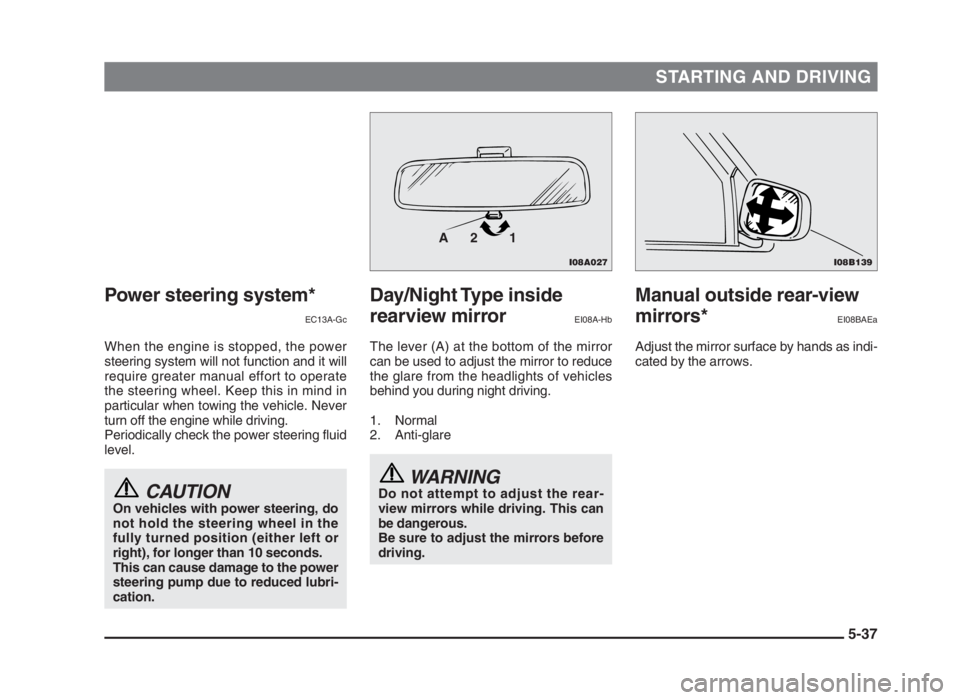
STARTING AND DRIVING
5-37
Power steering system*
EC13A-Gc
When the engine is stopped, the power
steering system will not function and it will
require greater manual effort to operate
the steering wheel. Keep this in mind in
particular when towing the vehicle. Never
turn off the engine while driving.
Periodically check the power steering fluid
level.
CAUTIONOn vehicles with power steering, do
not hold the steering wheel in the
fully turned position (either left or
right), for longer than 10 seconds.
This can cause damage to the power
steering pump due to reduced lubri-
cation.
Manual outside rear-view
mirrors*
EI08BAEa
Adjust the mirror surface by hands as indi-
cated by the arrows.
Day/Night Type inside
rearview mirror
EI08A-Hb
The lever (A) at the bottom of the mirror
can be used to adjust the mirror to reduce
the glare from the headlights of vehicles
behind you during night driving.
1. Normal
2. Anti-glare
WARNINGDo not attempt to adjust the rear-
view mirrors while driving. This can
be dangerous.
Be sure to adjust the mirrors before
driving.
I08B139I08A027
1 2 A
05engL2_240082_4 22-01-2004 13:05 Page 5-37
Page 176 of 264

FOR EMERGENCIES
If the vehicle breaks down
EN40B-Dc
If the vehicle breaks down on the road,
move it to the shoulder and use the
hazard warning flashers.
If the engine stops/fails
Vehicle operation and control are affected
if the engine stops. Before moving the ve-
hicle to a safe area, be aware of the fol-
lowing.
(1) The brake booster becomes inopera-
tive and the pedal effort will increase.
Press down the brake pedal harder
than usual.
(2) For vehicles with power steering,
since the power steering pump is no
longer operative, the steering wheel
feels heavy when turning it. Turn the
wheel with more effort than usual.
Operation under adverse
driving conditions
EI43APD
If your vehicle is stuck: in sand,
mud or snow
If the vehicle becomes stuck in snow,
sand, or mud, it can often be moved a
rocking motion. Move the selector lever
alternately between the “L” (LOW) and “R”
(REVERSE) position (with manual trans-
mission, between 1st and Reverse), while
applying slight pressure to the accelerator
pedal.
Avoid racing the engine or spinning the
wheels. Prolonged efforts to free a stuck
vehicle may result in overheating and
transmission failure. Allow the engine to
idle for a few minutes to let the transmis-
sion cool between rocking attempts.
If the vehicle remains stuck after several
rocking attempts, seek other assistance.
WARNINGWhen attempting to rock your vehi-
cle out of a stuck position, be sure
that the area around the vehicle is
clear of people and physical objects.
The rocking motion may cause the
vehicle to suddenly launch forward
or backward, causing injury or dam-
age to nearby people or objects.
On 2WD models, it is recommended to
start the vehicle with parking brake par-
tially, but not completely, applied by
slightly pulling the parking brake lever. Af-
ter the vehicle has become free, do not
forget to release the parking brake.
NOTE
Depress the accelerator pedal gradually
when starting the vehicle.
8-2
08engL2_240082_4 22-01-2004 13:10 Page 8-2
Page 177 of 264

FOR EMERGENCIES
On a flooded road
(1) Avoid flooded roads. Water could
enter the brake discs, resulting in
temporarily ineffective brakes. In such
cases, lightly depress the brake pedal
to see if the brakes operate properly.
If they do not, lightly depress the
pedal several times while driving in
order to dry the brake pads.
(2) When driving in rain or on a road with
many puddles a layer of water may
form between the tyres and the road
surface.
This reduces a tyre’s frictional
resistance on the road, resulting in
loss of steering stability and braking
capability.
To cope with this, observe the follow-
ing items:
(a) Drive your vehicle at a slow speed.
(b) Do not drive on worn tyres. Always
maintain the specified tyre inflation
pressures.
Tools, jack and jack handle
EN01A-T
The storage location of the tools and jack
should be remembered in case of an
emergency.
Location
1 - Tools
2 - Jack
3 - Jack handle
On a snow-covered or frozen road
(1) When driving on a snow-covered or
frozen road, it is recommended that
you use snow tyres or tyre chains.
Refer to the “Snow tyres” and “Tyre
chains” sections.
(2) Avoid high-speed operation, sudden
acceleration, abrupt brake application
and sharp cornering.
(3) Depressing the brake pedal during
travel on such a road may cause tyre
slippage and skidding. When traction
between the tyres and the road is re-
duced the wheels may skid and the
vehicle cannot readily be brought to a
stop by conventional braking tech-
niques. Braking will differ, depending
upon whether you have anti-lock
brakes (ABS). If you do have ABS,
brake by pressing the brake pedal
hard, and keeping it pressed. If you
do not have ABS, pump the brake
pedal with short rapid jabs, each time
fully applying and fully releasing for
greatest effect.
(4) Allow extra distance between your
vehicle and the vehicle in front of you,
and avoid sudden braking.
8-3
N01A044
3
2
1
Single cab
08engL2_240082_4 22-01-2004 13:10 Page 8-3
Page 193 of 264
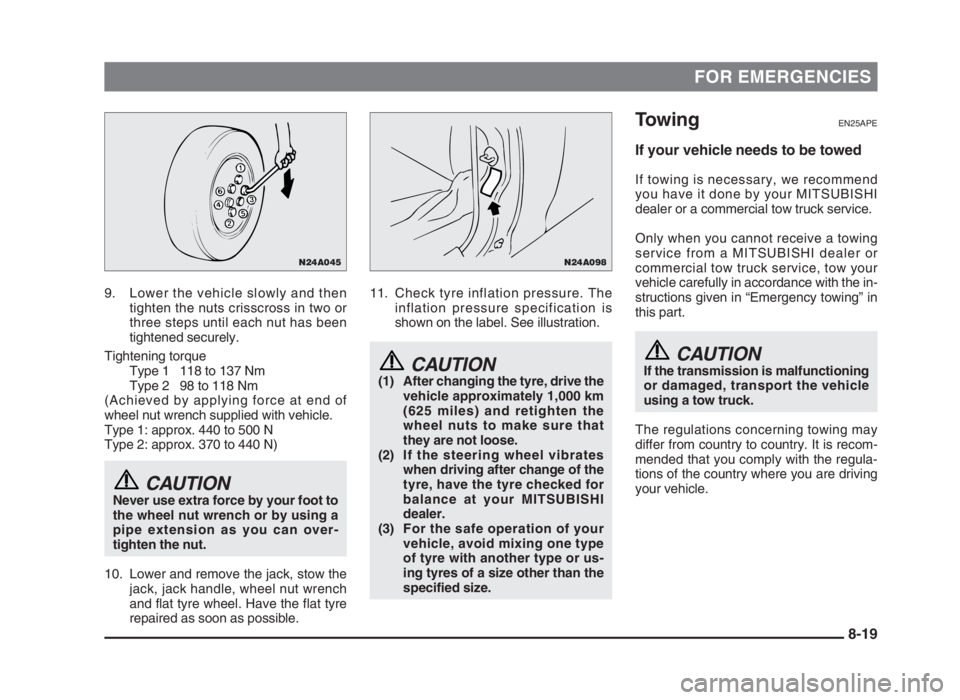
FOR EMERGENCIES
9. Lower the vehicle slowly and then
tighten the nuts crisscross in two or
three steps until each nut has been
tightened securely.
Tightening torque
Type 1 118 to 137 Nm
Type 2 98 to 118 Nm
(Achieved by applying force at end of
wheel nut wrench supplied with vehicle.
Type 1: approx. 440 to 500 N
Type 2: approx. 370 to 440 N)
CAUTIONNever use extra force by your foot to
the wheel nut wrench or by using a
pipe extension as you can over-
tighten the nut.
10. Lower and remove the jack, stow the
jack, jack handle, wheel nut wrench
and flat tyre wheel. Have the flat tyre
repaired as soon as possible.
TowingEN25APE
If your vehicle needs to be towed
If towing is necessary, we recommend
you have it done by your MITSUBISHI
dealer or a commercial tow truck service.
Only when you cannot receive a towing
service from a MITSUBISHI dealer or
commercial tow truck service, tow your
vehicle carefully in accordance with the in-
structions given in “Emergency towing” in
this part.
CAUTIONIf the transmission is malfunctioning
or damaged, transport the vehicle
using a tow truck.
The regulations concerning towing may
differ from country to country. It is recom-
mended that you comply with the regula-
tions of the country where you are driving
your vehicle.
11. Check tyre inflation pressure. The
inflation pressure specification is
shown on the label. See illustration.
CAUTION(1) After changing the tyre, drive the
vehicle approximately 1,000 km
(625 miles) and retighten the
wheel nuts to make sure that
they are not loose.
(2) If the steering wheel vibrates
when driving after change of the
tyre, have the tyre checked for
balance at your MITSUBISHI
dealer.
(3) For the safe operation of your
vehicle, avoid mixing one type
of tyre with another type or us-
ing tyres of a size other than the
specified size.
8-19
N24A098N24A045
08engL2_240082_4 22-01-2004 13:10 Page 8-19
Page 194 of 264
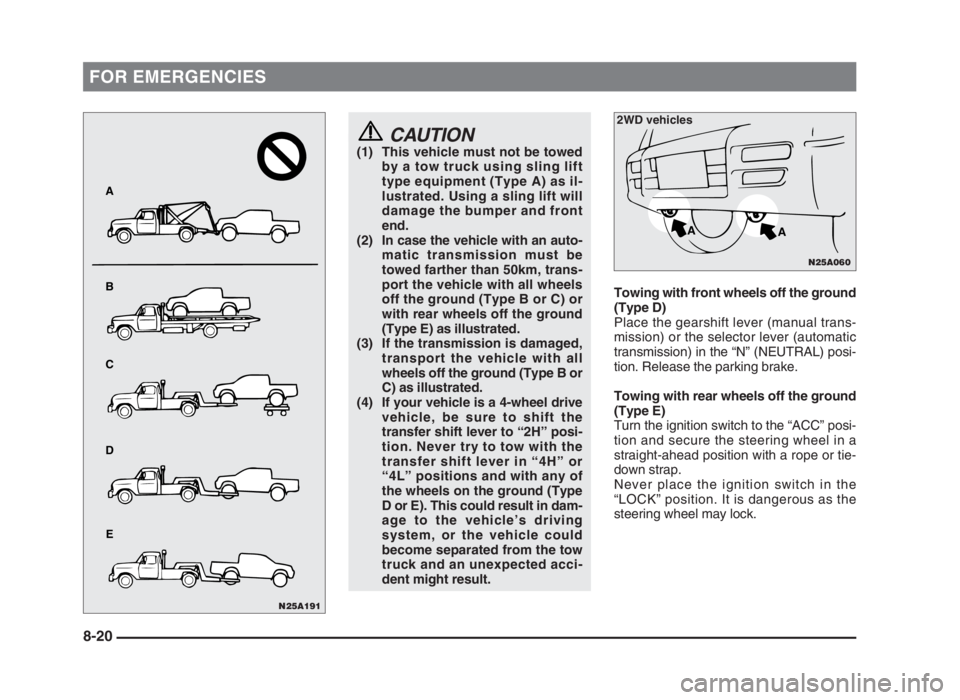
FOR EMERGENCIES
CAUTION(1) This vehicle must not be towed
by a tow truck using sling lift
type equipment (Type A) as il-
lustrated. Using a sling lift will
damage the bumper and front
end.
(2) In case the vehicle with an auto-
matic transmission must be
towed farther than 50km, trans-
port the vehicle with all wheels
off the ground (Type B or C) or
with rear wheels off the ground
(Type E) as illustrated.
(3) If the transmission is damaged,
transport the vehicle with all
wheels off the ground (Type B or
C) as illustrated.
(4) If your vehicle is a 4-wheel drive
vehicle, be sure to shift the
transfer shift lever to “2H” posi-
tion. Never try to tow with the
transfer shift lever in “4H” or
“4L” positions and with any of
the wheels on the ground (Type
D or E). This could result in dam-
age to the vehicle’s driving
system, or the vehicle could
become separated from the tow
truck and an unexpected acci-
dent might result.
Towing with front wheels off the ground
(Type D)
Place the gearshift lever (manual trans-
mission) or the selector lever (automatic
transmission) in the “N” (NEUTRAL) posi-
tion. Release the parking brake.
Towing with rear wheels off the ground
(Type E)
Turn the ignition switch to the “ACC” posi-
tion and secure the steering wheel in a
straight-ahead position with a rope or tie-
down strap.
Never place the ignition switch in the
“LOCK” position. It is dangerous as the
steering wheel may lock.
8-20
N25A060
A A
2WD vehicles
N25A191
A
B
E D C
08engL2_240082_4 22-01-2004 13:10 Page 8-20
Page 196 of 264
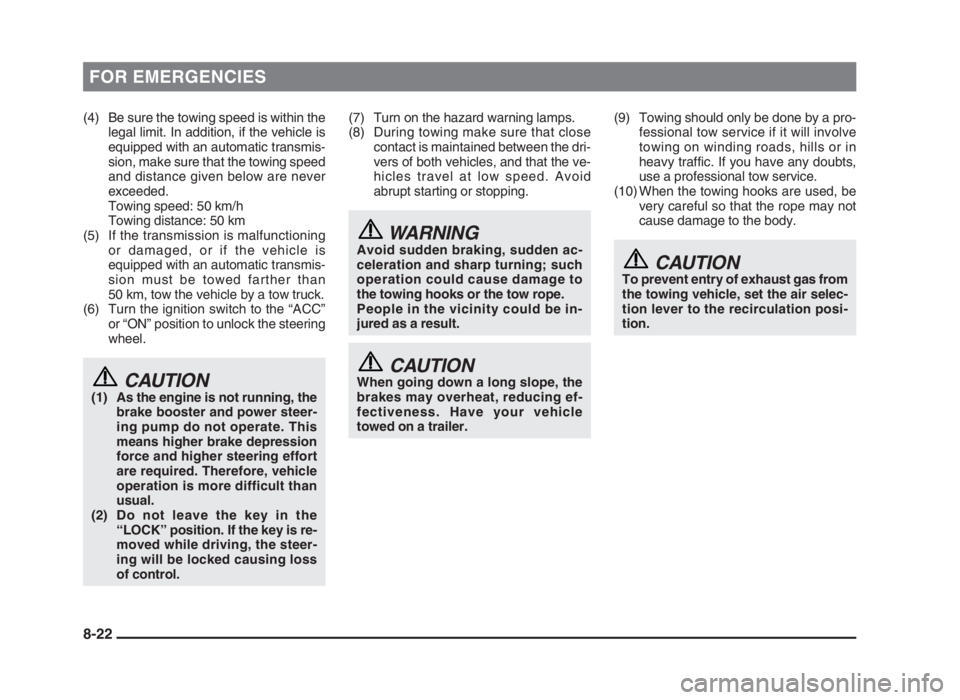
FOR EMERGENCIES
(4) Be sure the towing speed is within the
legal limit. In addition, if the vehicle is
equipped with an automatic transmis-
sion, make sure that the towing speed
and distance given below are never
exceeded.
Towing speed: 50 km/h
Towing distance: 50 km
(5) If the transmission is malfunctioning
or damaged, or if the vehicle is
equipped with an automatic transmis-
sion must be towed farther than
50 km, tow the vehicle by a tow truck.
(6) Turn the ignition switch to the “ACC”
or “ON” position to unlock the steering
wheel.
CAUTION(1) As the engine is not running, the
brake booster and power steer-
ing pump do not operate. This
means higher brake depression
force and higher steering effort
are required. Therefore, vehicle
operation is more difficult than
usual.
(2) Do not leave the key in the
“LOCK” position. If the key is re-
moved while driving, the steer-
ing will be locked causing loss
of control.
(7) Turn on the hazard warning lamps.
(8) During towing make sure that close
contact is maintained between the dri-
vers of both vehicles, and that the ve-
hicles travel at low speed. Avoid
abrupt starting or stopping.
WARNINGAvoid sudden braking, sudden ac-
celeration and sharp turning; such
operation could cause damage to
the towing hooks or the tow rope.
People in the vicinity could be in-
jured as a result.
CAUTIONWhen going down a long slope, the
brakes may overheat, reducing ef-
fectiveness. Have your vehicle
towed on a trailer.
(9) Towing should only be done by a pro-
fessional tow service if it will involve
towing on winding roads, hills or in
heavy traffic. If you have any doubts,
use a professional tow service.
(10) When the towing hooks are used, be
very careful so that the rope may not
cause damage to the body.
CAUTIONTo prevent entry of exhaust gas from
the towing vehicle, set the air selec-
tion lever to the recirculation posi-
tion.
8-22
08engL2_240082_4 22-01-2004 13:10 Page 8-22
Page 215 of 264
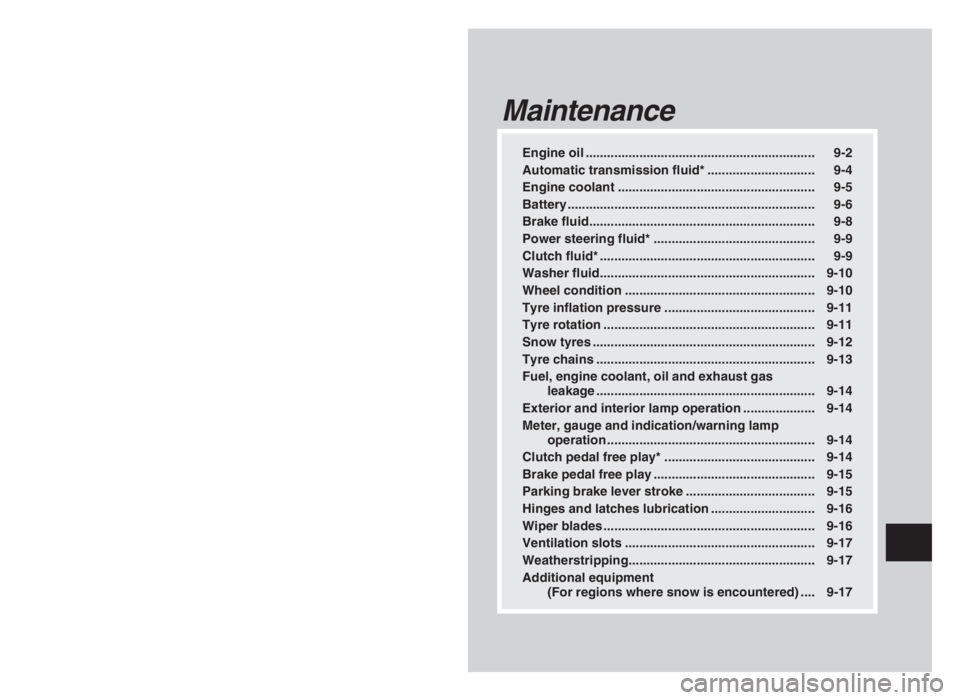
Engine oil ................................................................ 9-2
Automatic transmission fluid* .............................. 9-4
Engine coolant ....................................................... 9-5
Battery ..................................................................... 9-6
Brake fluid............................................................... 9-8
Power steering fluid* ............................................. 9-9
Clutch fluid* ............................................................ 9-9
Washer fluid............................................................ 9-10
Wheel condition ..................................................... 9-10
Tyre inflation pressure .......................................... 9-11
Tyre rotation ........................................................... 9-11
Snow tyres .............................................................. 9-12
Tyre chains ............................................................. 9-13
Fuel, engine coolant, oil and exhaust gas
leakage ............................................................. 9-14
Exterior and interior lamp operation .................... 9-14
Meter, gauge and indication/warning lamp
operation .......................................................... 9-14
Clutch pedal free play* .......................................... 9-14
Brake pedal free play ............................................. 9-15
Parking brake lever stroke .................................... 9-15
Hinges and latches lubrication ............................. 9-16
Wiper blades ........................................................... 9-16
Ventilation slots ..................................................... 9-17
Weatherstripping.................................................... 9-17
Additional equipment
(For regions where snow is encountered) .... 9-17
Maintenance
9
09engL2_240082_4 22-01-2004 13:12 Page 9-1
Page 227 of 264
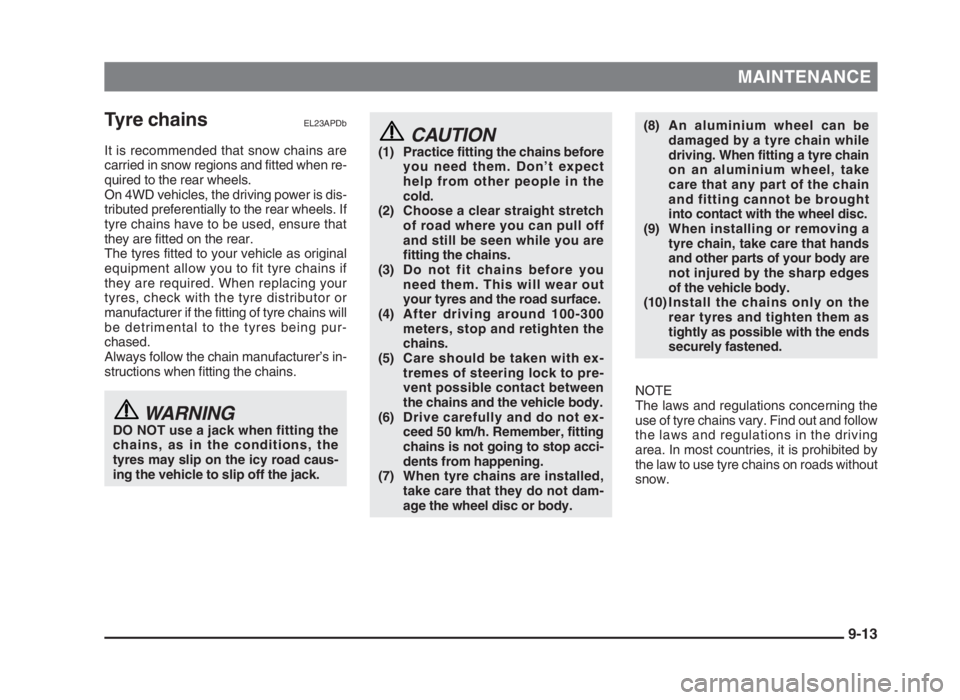
MAINTENANCE
Tyre chainsEL23APDb
It is recommended that snow chains are
carried in snow regions and fitted when re-
quired to the rear wheels.
On 4WD vehicles, the driving power is dis-
tributed preferentially to the rear wheels. If
tyre chains have to be used, ensure that
they are fitted on the rear.
The tyres fitted to your vehicle as original
equipment allow you to fit tyre chains if
they are required. When replacing your
tyres, check with the tyre distributor or
manufacturer if the fitting of tyre chains will
be detrimental to the tyres being pur-
chased.
Always follow the chain manufacturer’s in-
structions when fitting the chains.
WARNINGDO NOT use a jack when fitting the
chains, as in the conditions, the
tyres may slip on the icy road caus-
ing the vehicle to slip off the jack.
(8) An aluminium wheel can be
damaged by a tyre chain while
driving. When fitting a tyre chain
on an aluminium wheel, take
care that any part of the chain
and fitting cannot be brought
into contact with the wheel disc.
(9) When installing or removing a
tyre chain, take care that hands
and other parts of your body are
not injured by the sharp edges
of the vehicle body.
(10) Install the chains only on the
rear tyres and tighten them as
tightly as possible with the ends
securely fastened.
NOTE
The laws and regulations concerning the
use of tyre chains vary. Find out and follow
the laws and regulations in the driving
area. In most countries, it is prohibited by
the law to use tyre chains on roads without
snow.CAUTION(1) Practice fitting the chains before
you need them. Don’t expect
help from other people in the
cold.
(2) Choose a clear straight stretch
of road where you can pull off
and still be seen while you are
fitting the chains.
(3) Do not fit chains before you
need them. This will wear out
your tyres and the road surface.
(4) After driving around 100-300
meters, stop and retighten the
chains.
(5) Care should be taken with ex-
tremes of steering lock to pre-
vent possible contact between
the chains and the vehicle body.
(6) Drive carefully and do not ex-
ceed 50 km/h. Remember, fitting
chains is not going to stop acci-
dents from happening.
(7) When tyre chains are installed,
take care that they do not dam-
age the wheel disc or body.
9-13
09engL2_240082_4 22-01-2004 13:13 Page 9-13
Page 241 of 264
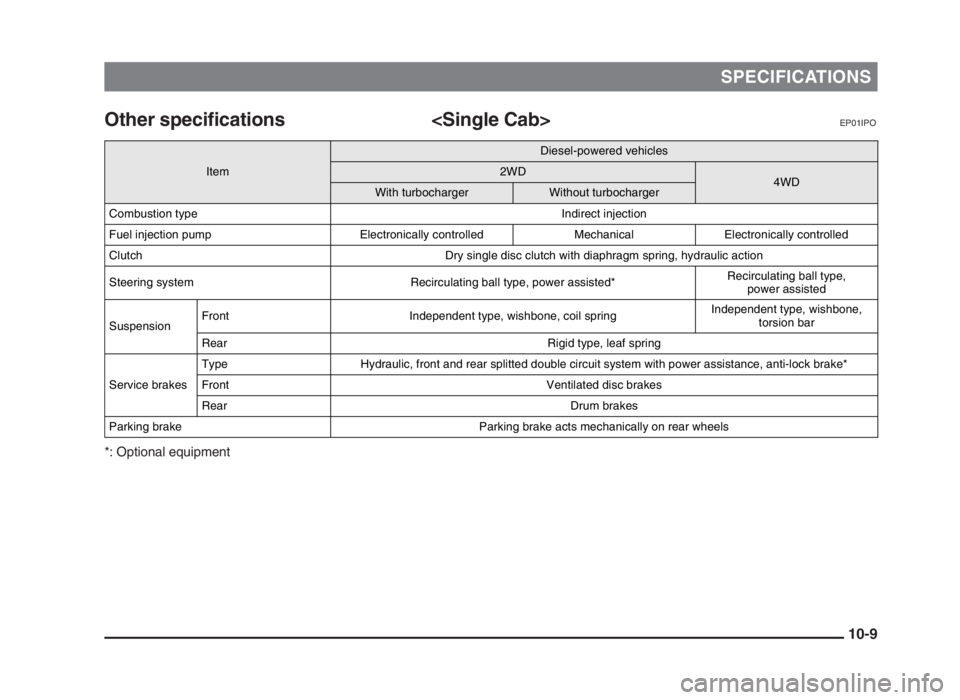
SPECIFICATIONS
Other specifications
*: Optional equipment
10-9
Item
Diesel-powered vehicles
2WD4WDWith turbochargerWithout turbocharger
Combustion type Indirect injection
Fuel injection pump Electronically controlled Mechanical Electronically controlled
Clutch Dry single disc clutch with diaphragm spring, hydraulic action
Steering system Recirculating ball type, power assisted*Recirculating ball type,
power assisted
SuspensionFront Independent type, wishbone, coil springIndependent type, wishbone,
torsion bar
Rear Rigid type, leaf spring
Service brakesType Hydraulic, front and rear splitted double circuit system with power assistance, anti-lock brake*
Front Ventilated disc brakes
Rear Drum brakes
Parking brake Parking brake acts mechanically on rear wheels
10engL2_240082_4 22-01-2004 13:14 Page 10-9
Page 247 of 264
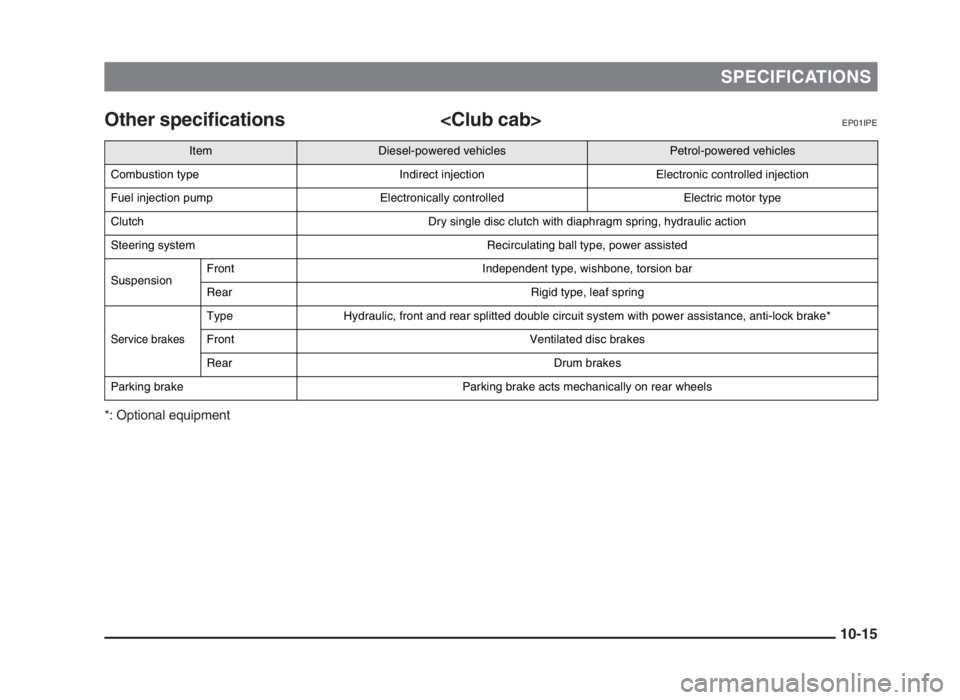
SPECIFICATIONS
Other specifications
*: Optional equipment
10-15
Item
Diesel-powered vehiclesPetrol-powered vehicles
Combustion type Indirect injection Electronic controlled injection
Fuel injection pump Electronically controlled Electric motor type
Clutch Dry single disc clutch with diaphragm spring, hydraulic action
Steering system Recirculating ball type, power assisted
SuspensionFront Independent type, wishbone, torsion bar
Rear Rigid type, leaf spring
Service brakes
Type Hydraulic, front and rear splitted double circuit system with power assistance, anti-lock brake*
Front Ventilated disc brakes
Rear Drum brakes
Parking brake Parking brake acts mechanically on rear wheels
10engL2_240082_4 22-01-2004 13:14 Page 10-15